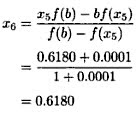The method of false position
Posted by Jonathan Celis
False position is a very interesting method and is commonly used when other methods does not converge.
Here, we start with an initial interval [x1,x2], and we assume that the function changes sign only once in this interval. Now we find an x3 in this interval, which is given by the intersection of the x axis and the straight line passing through (x1,f(x1)) and (x2,f(x2)). It is easy to verify that x3 is given by

Now, we choose the new interval from the two choices [x1,x3] or [x3,x2] depending on in which interval the function changes sign.
The false position method differs from the bisection method only in the choice it makes for subdividing the interval at each iteration. It converges faster to the root because it is an algorithm which uses appropriate weighting of the intial end points x1 and x2 using the information about the function, or the data of the problem. In other words, finding x3 is a static procedure in the case of the bisection method since for a given x1 and x2, it gives identical x3, no matter what the function we wish to solve. On the other hand, the false position method uses the information about the function to arrive at x3.
But for a better learning here is an example, i hope you enjoy it.
Example
FInd the root of the equation X2+X-1=0, with a=0 and b=1, using the false position method.
It is easy to verify that f(x)=X2+X- 1 and f"(x)=2. Since f(1)>0 and and f"(1)>0, therefor Xo=0 and b=1.
so
For n=0 we have:
For n=1 we have:
For n=2 we have:
For n=3 we have:
For n=4 we have:
For n=5 we have:
the required root of the equation X2+X- 1=0 is =0.618.
